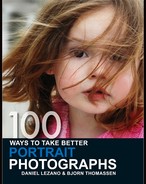35
Add movement to your subject
There are two main ways to capture movement in a portrait. The first is to freeze action with a fast shutter speed. The second is to use a slow shutter speed to capture motion as a blur. With this option, a common technique is to track a subject during the exposure so that it remains sharp while the background is blurred; this is known as panning. However, there are many instances when neither technique is appropriate. For example, you may want to capture a sharp subject, but cannot pan because the subject is not moving across the frame. In this case, it is best to use image-manipulation software such as Photoshop to recreate movement. Applying movement post-production has several advantages. You can control how much of the image receives Motion Blur, as well as its extent and direction. This opens up many creative possibilities, as you have the opportunity to introduce movement that is impossible via conventional methods.

CHILD’S PLAY
The main problem with this shot was ensuring that the subjects were sharp. The point where the children were at their highest was prefocused and the shutter button fired (with the camera set to continuous shooting) when they reached this point. An exposure of 1/200 sec was used to freeze the action and a wide aperture selected to throw the background out of focus. To convey a real sense of movement, Motion Blur was added in Photoshop around the periphery of the frame and to the children’s legs and hair.
Canon EOS-1DS, 28–70mm lens at 70mm, 1/200 sec at f/5, ISO 400.
